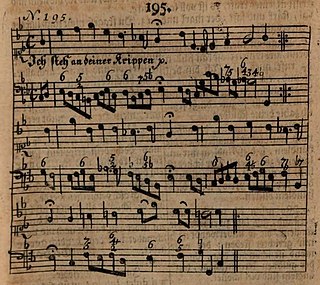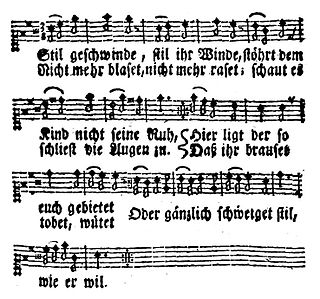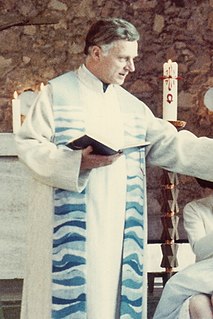Related Research Articles

"Gott sei gelobet und gebenedeiet" is a Lutheran hymn of 1524 with words written by Martin Luther who used an older first stanza and melody. It is a song of thanks after communion. Luther's version in three stanzas was printed in the Erfurt Enchiridion of 1524 and in Johann Walter's choral hymnal Eyn geystlich Gesangk Buchleyn the same year. Today, the song appears in German hymnals, including both the Protestant Evangelisches Gesangbuch, and in a different version in the Catholic Gotteslob.
Advent songs are songs and hymns intended for Advent, the four weeks of preparation for Christmas. Topics of the time of expectation are the hope for a Messiah, prophecies, and the symbolism of light, among others. Several of the songs are part of hymnals such as the German Catholic Gotteslob (GL) and the Protestant Evangelisches Gesangbuch (EG).

"Glauben können wie du" is a Christian poem by Helmut Schlegel, written in 2009, and made a hymn of the genre Neues Geistliches Lied with a melody by Joachim Raabe the same year. It addresses Mary, the mother of Jesus, to be imitated living the theological virtues of faith, hope and love. The song is included in song books and the Catholic hymnal Gotteslob.
"Den Herren will ich loben" is a Christian hymn by Maria Luise Thurmair, based on the Magnificat and set to a 1613 melody by Melchior Teschner, which was used for "Valet will ich dir geben". The hymn in three stanzas of eight lines was first written in 1954, and revised in 1971. It appeared in the Catholic hymnal Gotteslob in 1975, and in the current Gotteslob, but also in a German Protestant hymnal. A general song of praise, it has been set to music several times.

"Ich steh an deiner Krippen hier" is a German Christmas hymn, with lyrics by Paul Gerhardt which were first published in 1653. It was then sung with an older melody by Martin Luther, but a melody which was likely created by Johann Sebastian Bach for Schemellis Gesangbuch of 1736 is now part of current Protestant and Catholic hymnals.

"Erde, singe" is a German Catholic hymn with a text by Johannes Cardinal of Geissel, Archbishop of Cologne, written in 1837 as a Christmas carol in ten stanzas. The current Catholic hymnal Gotteslob has only four stanzas as GL 411, which are in the general section of praise.
"Nun singe Lob, du Christenheit" is a Christian hymn by Georg Thurmair, set to a 1653 melody by Johann Crüger. It is a song of praise, focused on unity within the church. The hymn in five stanzas of for lines each was written in 1964, revised in 1967. It is part of the current Catholic hymnal Gotteslob as GL 487, in the section "Kirche – Ökumene".
"Zeige uns, Herr, deine Allmacht und Güte" is a Christian hymn of penitence. The lyrics were written in the early 1980s by Raymund Weber. They were combined with a melody from the 1708 hymnal by Johann Anastasius Freylinghausen. The song in three stanzas appeared in the 2013 Catholic hymnal Gotteslob as GL 272 in the section for Lent.

"Gott, der du warst und bist und bleibst" is a Christian hymn with text by Eugen Eckert and a melody by Herbert Heine. It is also known by the title of its refrain, "Wir haben hier keine bleibende Stadt". The song was written in 1993, in the genre Neues Geistliches Lied (NGL). It appears in several regional sections of the German Catholic hymnal Gotteslob, and in other songbooks.

"Dein Lob, Herr, ruft der Himmel aus" is a German Catholic hymn. Adolf Lohmann adapted a 1659 hymn by the Jesuit astronomer Albert Curtz, who paraphrased Psalm 19. The melody appeared in Augsburg in 1669. It was No. 1 in the 1938 hymnal Kirchenlied and is part of the German Catholic hymnal Gotteslob as GL 381.
"Nun lässest du, o Herr" is a Christian hymn by Georg Thurmair written in 1966 as a paraphrase of the Nunc dimittis canticle. It was part of the German Catholic hymnal Gotteslob of 1975 as GL 660 with a 16th-century melody by Loys Bourgeois. With this melody, it is also part of the Protestant hymnal Evangelisches Gesangbuch as EG 695. It is part of the second edition of the Gotteslob as GL 500, with a new 1994 melody.
"O Licht der wunderbaren Nacht" is a Christian Easter hymn by Georg Thurmair written in 1963. It was part of the German Catholic hymnal Gotteslob of 1975 as GL 208, with a melody from the 14th century. It is part of the second edition of the Gotteslob as GL 334, also of regional sections of the Protestant hymnal Evangelisches Gesangbuch.

"Seht, er lebt" is a Christian poem written by the Catholic priest Lothar Zenetti in 1973. With an Israeli melody, it became an Easter hymn in the Neues Geistliches Lied (NGL) genre, first published in 1975. In the 2013 Catholic hymnal Gotteslob, it appears as GL 781 in the regional section for the Diocese of Limburg.

"Meine engen Grenzen" is a Christian poem by Eugen Eckert, written in 1981, and made a hymn of the genre Neues Geistliches Lied with a melody and setting by Winfried Heurich the same year. The song, bringing one's shortcomings and limitations before God and praying for a broader perspective, is part of the common German Protestant and Catholic hymnals, and of other songbooks.
"Das Jahr steht auf der Höhe" is a Christian hymn in German with a text by Detlev Block written in 1978 to an older melody by Johann Steuerlein. In the modern German Catholic hymnal Gotteslob, it appears as GL 465. The hymn initially focuses on observing nature and then compares its transience to that of human life.

Cantate! (Sing!) is a German Catholic hymnal first published in 1847, and continued in seven editions until 1879. It was a collection of 444 old and new songs, edited by the educator and hymnwriter Heinrich Bone, and the first Catholic hymnal in German that was used in multiple dioceses. Several of the songs are still part of the common Catholic hymnal in German, Gotteslob.
"Der am Kreuz ist meine Liebe" is the beginning of Passion hymns in German. One version was written by Johann Mentzer as a translation of the Latin "Amor meus crucifixus est", attributed to Ignatius of Loyola, to the melody of "Werde munter, mein Gemüte". A famous version was written by Friedrich Gottlieb Klopstock, in six stanzas, and first published in 1758. It was associated with the melody used first for "Freue dich, du meine Seele".

"Seht, der Stein ist weggerückt" is an Easter hymn in German with text written by the Catholic priest Lothar Zenetti in 1971. With a 2011 melody by Josef Oestemer, it became a Neues Geistliches Lied (NGL) published in 2013 in the Catholic hymnal Gotteslob, as GL 783 in the regional section for the Diocese of Limburg.
"Alle Menschen höret auf dies neue Lied" is a Christian offertory hymn with German text, translated in 1972 by Sigisbert Kraft from a 1966 Dutch hymn by Simon Jelsma with a melody by Wim ter Burg. It appeared from 1975 in German hymnals and song books.
"Hilf, Herr meines Lebens" is a Christian hymn, with a text mostly written in 1961 by Gustav Lohmann, and a melody composed the following year by Hans Puls. The song, of the genre Neues Geistliches Lied (NGL), is part of German hymnals, including Gotteslob, and songbooks. It begins: "Hilf, Herr meines Lebens, dass ich nicht vergebens hier auf Erden bin".
